A Step In The Right Direction
It always seems to happen this way. Last week the title of my weekly missive was, "All is not right with the world." The key point I wanted to make was that while the U.S. stock market looked to be in pretty good shape, the world markets were not. And since the best bull market runs tend to be global in scope, I thought it made sense to alert readers to what I perceived to be an important risk factor.
So, what did Ms. Market do with my global macro warning? Step lively to new all-time highs, of course - LOL!
Such is the game we play and one of the primary reasons I don't believe in trying to make "calls" on what is about to happen next in Ms. Market's game. I've been in the business of investing since mid-1980 and I can say with absolute certainty that no one has been able to consistently "call" the next move in the market for any length of time.
Sure, I could hammer away at the keyboard this morning and 'esplain' that these types of divergences tend to occur late in the cycle and that we should keep our eyes peeled for trouble ahead. I could point to any number of scary numbers to make myself feel better about my "warning." I could even go so far as to say that I will be "right" in the end.
Lessons Learned
But here is a lesson I learned from Ned Davis a LONG time ago. Unless you make your living selling advertisements (which requires consistent "eyeballs" on your musings and everybody in the publishing business knows that fear sells), the business of investing isn't about "being right." No, it's about "getting it right" and "making hay while the sun shines." And make no mistake about it; with the S&P 500 closing the week at a fresh all-time high, the sun appears to be still shining on the stock market.
Again, I could sit here and opine that there are storm clouds gathering on the horizon. That might make my recent urgings toward "some caution" a bit easier to take. But here's the problem. My "State of the Tape" model remains in great shape. And both my "Desert Island" and "External Factors" models (all three models are shown in the Primary Cycle Board below) flashed buy signals last week.
Check Your Ego At The Door
Although the signals occurred by the skinniest of margins, my rules-based approach to investing tells me to "check your ego at the door" and get in line what the indicators say "IS" happening. To be sure, this can get uncomfortable at times - especially as we enter what is historically one of the seasonally weakest periods of the year. But as I have also learned over the years, the more angst I feel about making an adjustment to my exposure in the stock market, the more likely the move is to be profitable. (Insert laughing/crying-eyes emoji here!).
To clarify, I added "some" exposure to the stock market in response to the signals from my "Desert Island" and External Factors models. As you likely know, I don't believe in putting all of my portfolio management eggs in any single indicator basket. No, I prefer to employ a "team" approach by using a group of indicators/models.
My Battle Cry
The idea here is that ALL indicators/models stumble or "get fooled" by the action at times. As such, I want to limit my exposure to what I call the "singular failure" of any one model/indicator/signal. The bottom line is my battle cry is to try my darndest to get it "mostly right, most of the time" in terms of the market's risk/reward environment.
In other words, I want to manage money in a way that limits the opportunity to make "the big mistake." To do this, I need to remove emotion and create rules to follow. Again, this is NOT a single "holy grail" indicator that I dreamed up and I alone have access to that allows me to buy the bottoms of market declines and sell the tops of bull moves.
Just so we are clear, I believe such a task is a fool's errand. No, I prefer to have a team of indicators designed help me stay on the correct side of the prevailing environment. And with four of my five "Primary Cycle" models on buy signals, there can be little argument that the bulls are in control of the game here.
The Outlook
Does this mean that stocks will dance merrily higher from here? Frankly, I doubt it. Gun to the head; I think the choppy, news-driven environment is likely to stick around a while. The President's legal issues are troubling and aren't likely to go away during the mid-term election season. Despite the two sides talking, there was no improvement in the state of the trade war with China last week. And while Jay Powell did sound a bit more dovish in his speech at the Jackson Hole symposium on Friday, Powell's merry band of central bankers is still likely to keep pushing rates back to the neutral zone.
But with consumer spending looking strong, the economy humming along, earnings at all-time highs, and a couple of my favorite models flashing buy signals, I simply can't be overly negative at this point in time.
So, while I still believe that "some" caution is warranted (as in, stay away from the margin account for now and maybe keep a little powder dry on the sidelines for opportunities), this week's action is clearly a step in the right direction.
Moving On... Now let's turn to the weekly review of my favorite indicators and market models... "But first a word from our sponsor ;-)"...
INTRODUCING: THE ELEVATION STRATEGY
A Tax-Efficient Risk Management Strategy for the U.S. Stock Market
Believed to be unique in the industry, the Elevation strategy is a long-term, risk-managed portfolio solution designed for growth-oriented investors seeking a tax-efficient, risk-managed approach to the stock market. Our tests show that 75% of the Strategy's profitable trades since 3/31/1999 would have qualified as long-term for tax purposes.
The State of the Big-Picture Market Models
I like to start each week with a review of the state of my favorite big-picture market models, which are designed to help me determine which team is in control of the primary cycle.
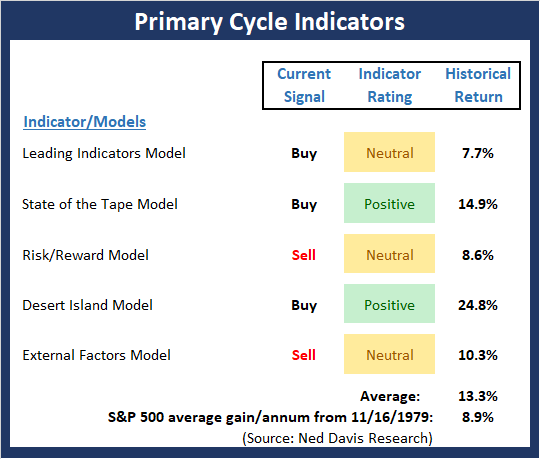
View My Favorite Market Models Online
The Bottom Line:
- The good news for the Primary Cycle board this week is both the "Desert Island" model (the model I would choose if I were stranded on a desert island and only had access to one indicator) and the External Factors model both flashed a buy signal and moved up into the positive zone (albeit by the slimmest of margins). And despite the Leading Indicators model slipping back into the neutral zone, the historical return for the S&P 500 given the current model readings is solidly above the mean.
The State of the Trend
Once I've reviewed the big picture, I then turn to the "state of the trend." These indicators are designed to give us a feel for the overall health of the current short- and intermediate-term trend models.
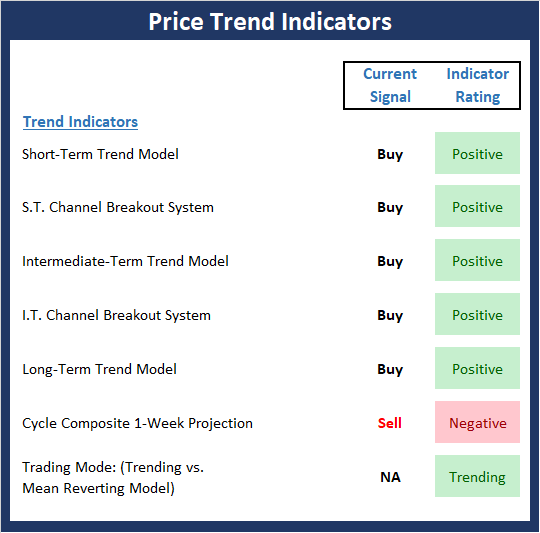
View Trend Indicator Board Online
The Bottom Line:
- The Trend Board remains in good shape. However, we should note that the cycle composite now turns down for the seasonal weak period. In short, a choppy downtrend is now projected until mid-October.
The State of Internal Momentum
Next up are the momentum indicators, which are designed to tell us whether there is any "oomph" behind the current trend.
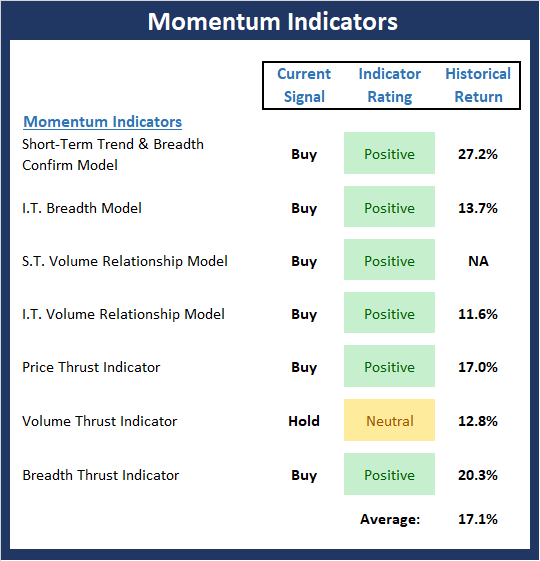
View Momentum Indicator Board Online
The Bottom Line:
- The Momentum board showed some much-needed improvement this week and the historical return of the current state of the board is well nearly double the historical mean. But (you knew that was coming), while the "thrust" indicators are in better shape, we have yet to see longer-term "thrust" buy signals, which historically have given the bulls an "all clear" signal for the coming 12 months. But for now, things are in good shape here.
The State of the "Trade"
We also focus each week on the "early warning" board, which is designed to indicate when traders might start to "go the other way" -- for a trade.
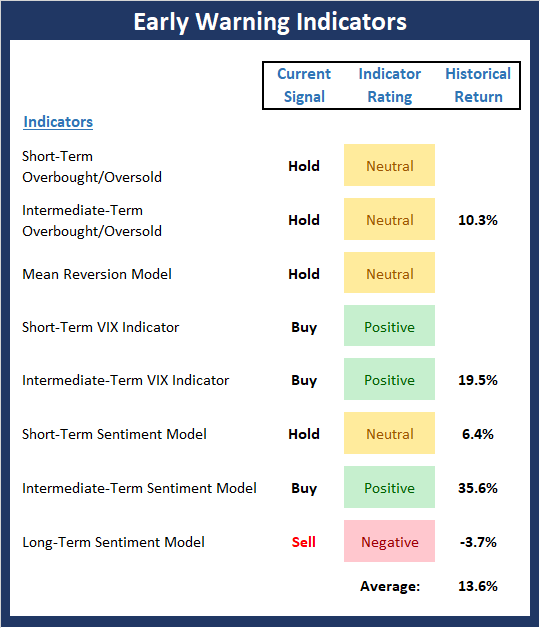
View Early Warning Indicator Board Online
The Bottom Line:
- The "Early Warning" board is largely neutral at this stage. However, I'll note that the intermediate-term sentiment model flashed a buy signal last week. This is interesting given that stocks notched all-time highs.
The State of the Macro Picture
Now let's move on to the market's "external factors" - the indicators designed to tell us the state of the big-picture market drivers including monetary conditions, the economy, inflation, and valuations.
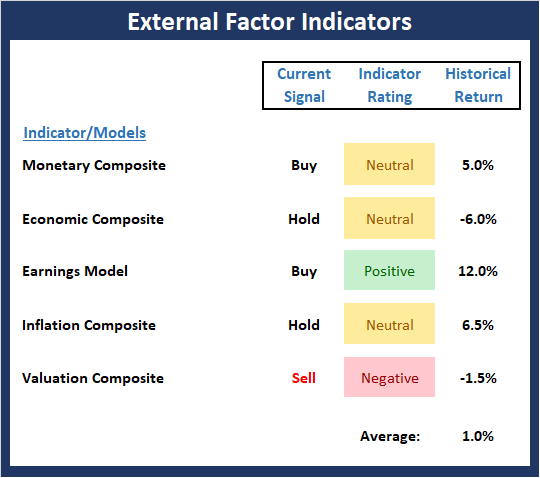
View External Factors Indicator Board Online
The Bottom Line:
- While it is hard to see, the External Factors board improved again this week as the Monetary Composite upticked, which pushed the historical return from negative to positive. It is also worth noting again that the Inflation Composite model is now neutral, which is a good thing for bond investors. But, as I've been saying, there can be no denying that External Factors board leaves a lot to be desired here.
Thought For The Day:
A man who fears suffering is already suffering from what he fears. - Montaigne
Wishing you green screens and all the best for a great day,

David D. Moenning
Founder, Chief Investment Officer
Heritage Capital Research
HCR Focuses on a Risk-Managed Approach to Investing
What Risk Management Can and Cannot Do
ANNOUNCEMENT:
HCR Awarded Top Honors in 2018 NAAIM Shark Tank Portfolio Strategy Competition
Each year, NAAIM (National Association of Active Investment Managers) hosts a competition to identify the best actively managed investment strategies. In April, HCR's Dave Moenning took home first place for his flagship risk management strategy.
Disclosures
At the time of publication, Mr. Moenning held long positions in the following securities mentioned: None - Note that positions may change at any time.
Indicators Explained
Short-Term Trend-and-Breadth Signal Explained: History shows the most reliable market moves tend to occur when the breadth indices are in gear with the major market averages. When the breadth measures diverge, investors should take note that a trend reversal may be at hand. This indicator incorporates NDR's All-Cap Dollar Weighted Equity Series and A/D Line. From 1998, when the A/D line is above its 5-day smoothing and the All-Cap Equal Weighted Equity Series is above its 25-day smoothing, the equity index has gained at a rate of +32.5% per year. When one of the indicators is above its smoothing, the equity index has gained at a rate of +13.3% per year. And when both are below, the equity index has lost +23.6% per year.
Channel Breakout System Explained: The short-term and intermediate-term Channel Breakout Systems are modified versions of the Donchian Channel indicator. According to Wikipedia, "The Donchian channel is an indicator used in market trading developed by Richard Donchian. It is formed by taking the highest high and the lowest low of the last n periods. The area between the high and the low is the channel for the period chosen."
Intermediate-Term Trend-and-Breadth Signal Explained: This indicator incorporates NDR's All-Cap Dollar Weighted Equity Series and A/D Line. From 1998, when the A/D line is above its 45-day smoothing and the All-Cap Equal Weighted Equity Series is above its 45-day smoothing, the equity index has gained at a rate of +17.6% per year. When one of the indicators is above its smoothing, the equity index has gained at a rate of +6.5% per year. And when both are below, the equity index has lost -1.3% per year.
Cycle Composite Projections: The cycle composite combines the 1-year Seasonal, 4-year Presidential, and 10-year Decennial cycles. The indicator reading shown uses the cycle projection for the upcoming week.
Trading Mode Indicator: This indicator attempts to identify whether the current trading environment is "trending" or "mean reverting." The indicator takes the composite reading of the Efficiency Ratio, the Average Correlation Coefficient, and Trend Strength models.
Volume Relationship Models: These models review the relationship between "supply" and "demand" volume over the short- and intermediate-term time frames.
Price Thrust Model Explained: This indicator measures the 3-day rate of change of the Value Line Composite relative to the standard deviation of the 30-day average. When the Value Line's 3-day rate of change have moved above 0.5 standard deviation of the 30-day average ROC, a "thrust" occurs and since 2000, the Value Line Composite has gained ground at a rate of +20.6% per year. When the indicator is below 0.5 standard deviation of the 30-day, the Value Line has lost ground at a rate of -10.0% per year. And when neutral, the Value Line has gained at a rate of +5.9% per year.
Volume Thrust Model Explained: This indicator uses NASDAQ volume data to indicate bullish and bearish conditions for the NASDAQ Composite Index. The indicator plots the ratio of the 10-day total of NASDAQ daily advancing volume (i.e., the total volume traded in stocks which rose in price each day) to the 10-day total of daily declining volume (volume traded in stocks which fell each day). This ratio indicates when advancing stocks are attracting the majority of the volume (readings above 1.0) and when declining stocks are seeing the heaviest trading (readings below 1.0). This indicator thus supports the case that a rising market supported by heavier volume in the advancing issues tends to be the most bullish condition, while a declining market with downside volume dominating confirms bearish conditions. When in a positive mode, the NASDAQ Composite has gained at a rate of +38.3% per year, When neutral, the NASDAQ has gained at a rate of +13.3% per year. And when negative, the NASDAQ has lost at a rate of -8.25% per year.
Breadth Thrust Model Explained: This indicator uses the number of NASDAQ-listed stocks advancing and declining to indicate bullish or bearish breadth conditions for the NASDAQ Composite. The indicator plots the ratio of the 10-day total of the number of stocks rising on the NASDAQ each day to the 10-day total of the number of stocks declining each day. Using 10-day totals smooths the random daily fluctuations and gives indications on an intermediate-term basis. As expected, the NASDAQ Composite performs much better when the 10-day A/D ratio is high (strong breadth) and worse when the indicator is in its lower mode (weak breadth). The most bullish conditions for the NASDAQ when the 10-day A/D indicator is not only high, but has recently posted an extreme high reading and thus indicated a thrust of upside momentum. Bearish conditions are confirmed when the indicator is low and has recently signaled a downside breadth thrust. In positive mode, the NASDAQ has gained at a rate of +22.1% per year since 1981. In a neutral mode, the NASDAQ has gained at a rate of +14.5% per year. And when in a negative mode, the NASDAQ has lost at a rate of -6.4% per year.
Short-Term Overbought/sold Indicator: This indicator is the current reading of the 14,1,3 stochastic oscillator. When the oscillator is above 80 and the %K is above the %D, the indicator gives an overbought reading. Conversely, when the oscillator is below 20 and %K is below its %D, the indicator is oversold.
Intermediate-Term Overbought/sold Indicator: This indicator is a 40-day RSI reading. When above 57.5, the indicator is considered overbought and when below 45 it is oversold.
Mean Reversion Model: This is a diffusion model consisting of five indicators that can produce buy and sell signals based on overbought/sold conditions.
VIX Indicator: This indicator looks at the current reading of the VIX relative to standard deviation bands. When the indicator reaches an extreme reading in either direction, it is an indication that a market trend could reverse in the near-term.
Short-Term Sentiment Indicator: This is a model-of-models composed of 18 independent sentiment indicators designed to indicate when market sentiment has reached an extreme from a short-term perspective. Historical analysis indicates that the stock market's best gains come after an environment has become extremely negative from a sentiment standpoint. Conversely, when sentiment becomes extremely positive, market returns have been subpar.
Intermediate-Term Sentiment Indicator: This is a model-of-models composed of 7 independent sentiment indicators designed to indicate when market sentiment has reached an extreme from an intermediate-term perspective. Historical analysis indicates that the stock market's best gains come after an environment has become extremely negative from a sentiment standpoint. Conversely, when sentiment becomes extremely positive, market returns have been subpar.
Long-Term Sentiment Indicator: This is a model-of-models composed of 6 independent sentiment indicators designed to indicate when market sentiment has reached an extreme from a long-term perspective. Historical analysis indicates that the stock market's best gains come after an environment has become extremely negative from a sentiment standpoint. Conversely, when sentiment becomes extremely positive, market returns have been subpar.
Absolute Monetary Model Explained: The popular cliché, "Don't fight the Fed" is really a testament to the profound impact that interest rates and Fed policy have on the market. It is a proven fact that monetary conditions are one of the most powerful influences on the direction of stock prices. The Absolute Monetary Model looks at the current level of interest rates relative to historical levels and Fed policy.
Relative Monetary Model Explained: The "relative" monetary model looks at monetary indicators relative to recent levels as well as rates of change and Fed Policy.
Economic Model Explained: During the middle of bull and bear markets, understanding the overall health of the economy and how it impacts the stock market is one of the few truly logical aspects of the stock market. When our Economic model sports a "positive" reading, history (beginning in 1965) shows that stocks enjoy returns in excess of 21% per year. Yet, when the model's reading falls into the "negative" zone, the S&P has lost nearly -25% per year. However, it is vital to understand that there are times when good economic news is actually bad for stocks and vice versa. Thus, the Economic model can help investors stay in tune with where we are in the overall economic cycle.
Inflation Model Explained: They say that "the tape tells all." However, one of the best "big picture" indicators of what the market is expected to do next is inflation. Simply put, since 1962, when the model indicates that inflationary pressures are strong, stocks have lost ground. Yet, when inflationary pressures are low, the S&P 500 has gained ground at a rate in excess of 13%. The bottom line is inflation is one of the primary drivers of stock market returns.
Valuation Model Explained: If you want to get analysts really riled up, you need only to begin a discussion of market valuation. While the question of whether stocks are overvalued or undervalued appears to be a simple one, the subject is extremely complex. To simplify the subject dramatically, investors must first determine if they should focus on relative valuation (which include the current level of interest rates) or absolute valuation measures (the more traditional readings of Price/Earnings, Price/Dividend, and Price/Book Value). We believe that it is important to recognize that environments change. And as such, the market's focus and corresponding view of valuations are likely to change as well. Thus, we depend on our Valuation Models to help us keep our eye on the ball.
Disclosures
The opinions and forecasts expressed herein are those of Mr. David Moenning and may not actually come to pass. Mr. Moenning's opinions and viewpoints regarding the future of the markets should not be construed as recommendations. The analysis and information in this report is for informational purposes only. No part of the material presented in this report is intended as an investment recommendation or investment advice. Neither the information nor any opinion expressed constitutes a solicitation to purchase or sell securities or any investment program.
Any investment decisions must in all cases be made by the reader or by his or her investment adviser. Do NOT ever purchase any security without doing sufficient research. There is no guarantee that the investment objectives outlined will actually come to pass. All opinions expressed herein are subject to change without notice. Neither the editor, employees, nor any of their affiliates shall have any liability for any loss sustained by anyone who has relied on the information provided.
Mr. Moenning may at times have positions in the securities referred to and may make purchases or sales of these securities while publications are in circulation. Positions may change at any time.
The analysis provided is based on both technical and fundamental research and is provided "as is" without warranty of any kind, either expressed or implied. Although the information contained is derived from sources which are believed to be reliable, they cannot be guaranteed.
Investments in equities carry an inherent element of risk including the potential for significant loss of principal. Past performance is not an indication of future results.

